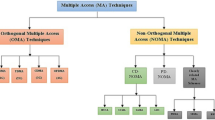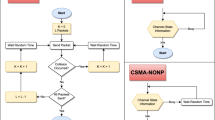Abstract
A combined control of multimedia quality level, mobility and allocation of network resources is essential for the success of next generation mobile networks. In this context, this article presents the Multi-user Session Control (MUSC) solution to control the quality level of multimedia sessions shared by multiple-users, providing Quality of Service (QoS) mapping and QoS adaptation for those sessions over heterogeneous and mobile networks. MUSC uses the self-organized principle to coordinate QoS mapping and QoS adaptation mechanisms with mobility and resource allocation controllers, allowing the adaptation of a session to the current network conditions and the dynamic selection of the suitable network service class to map the session. MUSC minimizes the blocking probability, optimizes the usage of network resources and keeps sessions with an acceptable quality of experience. MUSC was evaluated in a simulation and in an experimental environment to analyze its convergence time, percentage of session blocking as well as delay, throughput, Peak Signal-to-Noise Ratio (PSNR), Mean Option Scores (MOS) and Structural Similarity Index (SSIM) of sessions in QoS-aware mobile scenarios.












Similar content being viewed by others
References
Shanableh T, Ghanabari M (2005) Multilayer transcoding with format portability for multicasting of single-layered video. IEEE Trans Multimedia 7, February
Babiarz J,Chan K, Baker F (2006) Configuration guidelines for DiffServ service classes. IETF RFC 4594, August
Johnson D, Perkins C, Arkko J (2004) Mobility Support in IPv6. IETF RFC 3775, June
Rosenberg J et al (2002) SIP: Session initiation protocol. IETF RFC 3261, June
Zhou L, Sun Y (2006) An analysis of multicast support for mobile hosts using mobile IPv6. In: Proc. of IEEE International Conference on Wireless Communications, Networking and Mobile Computing, Wuhan, China, September
Cerqueira E et al (2007) QoS Mapping and adaptation in next generation networks. In Proceedings of IEEE International Symposium on Applications and the Internet Workshop, Hiroshima, Japan, January
Cerqueira E et al (2007) QoS mapping and adaptation control for multi-user sessions over heterogeneous wireless networks. In: Proceedings of ACM International Mobile Multimedia Communications Conference, Nafpaktos, Greece, August
Mammeri Z (2005) Approach for end-to-end QoS mapping and handling. In: Proceedings of IEEE/IFIP Wireless and Optical Communications Networks, Dubai, UAE, March
Ben Ali R et al (2005) UMTS-to-IP QoS mapping for voice and video telephony service. IEEE Netw 19:26–32
Chen J et al (2005) An integrated QoS control architecture for IEEE 802.16 broadband wireless access systems. In: Proceedings of IEEE Global Telecommunications Conference, St. Louis, MO, USA, November
El-Gendy M et al (2004) Paving the first mile for QoS-dependent applications and appliances. In: Proceedings of IEEE International Workshop on QoS, Montreal, Canada, June
Ruy M et al (2006) QoS class mapping over heterogeneous networks using Application Service Map. In: Proceedings of IEEE International Conference on Networking, International Conference on Systems and International Conference on Mobile Communications and Learning Technologies, Washington, USA, April
Schantz R et al (2006) Controlling quality-of-service in distributed real-time and embedded systems via adaptive middleware: experiences with auto-adaptive and reconfigurable systems. Softw Pract Exp 36:1189–1208
Rajan G et al (2006) Policy based QoS architecture in MUSE. In: Proceedings of IEEE Conference on Computer Communications, Barcelona, Spain, April
Johansen S, Kim A, Perkis A (2007) Quality incentive assisted congestion control for receiver-driven multicast. In Proceedings of IEEE International Conference on Communications, Glasgow, UK, June
Kim J et al (2006) Efficient video transcoding technique for QoS-based home gateway service. IEEE Trans Consum Electron 52(1):129–137
Zhu P, Zeng W, Li C (2007) Joint design of source rate control and QoS-aware congestion control for video streaming over the internet. IEEE Trans Multimedia 9(2):366–376
Cerqueira E et al (2006) A unifying architecture for publish-subscribe services in the next generation IP networks. In: Proceedings of IEEE Global Telecommunications Conference, San Francisco, USA, November
Cerqueira E et al (2007) Q3M: QoS architecture for multi-user mobile multimedia sessions in 4G systems. In: Proceedings of IFIP/IEEE International Conference on Management of Multimedia and Mobile Networks and Service, San Jose, USA, October
Cerqueira E et al (2006) Multi-user session control in the next generation wireless system. In: Proceedings of ACM International Workshop on Mobility Management and Wireless Access, Torremolinos, Spain, October
Hancook R et al (2005) Next step in signaling (NSIS): framework. IETF RFC 4080, June
Ash J et al (2008) QoS NSLP QSPEC template. IETF internet draft, February
Handley M, Jacobson V, Perkins C (2006) SDP: session description protocol. IETF RFC 4566, July
Bhattacharyya S (2003) An overview of source-specific multicast (SSM). IETF RFC 3569, July
Moy J (1998) OSPF version 2. IETF RFC 2328, April
Rekhter Y, Li T, Hare S (2006) A border gateway protocol 4 (BGP-4). IETF RFC 4271, January
Veloso L et al (2007) Seamless mobility of users for media distribution services. In: Proceedings of IEEE International Performance Computing and Communications Conference, New Orleans, USA, April
Chaskar H (2003) Requirements of a Quality of Service (QoS) Solution for Mobile IP. IETF RFC 3583, September
Veloso L et al (2007) Seamless Mobility of Users with QoS and Connectivity Support. In: Proceedings of IEEE Conference on Wireless and Mobile Computing, Networking and Communications, New York, USA, October
Neto A et al (2008) An integrated approach to control the quality level of multi-user sessions. In: Proceedings of ACM International Workshop on the Evaluation of Quality of Service through Simulation in the Future Internet, Marseille, France, March
Neto A et al (2007) A resource reservation protocol supporting QoS-aware multicast trees for next generation networks. In: Proceedings of IEEE Symposium on Computers and Communications, Aveiro, Portugal, July
Ash J et al (2008) QoS NSLP QSPEC template. IETF internet draft, February
Mendes P, Andres-Colas J, Pinho C (2005) Information model for the specification of QoS agreements among ambient networks. In Proceedings of IEEE Symposium on Personal Indoor and Mobile Radio Communications, Berlin, Germany, September
Chen X et al (2006) Supporting QoS in IEEE 802.11e Wireless LANs. IEEE Trans Wireless Commun 5(8):2217–2227
Mendes P, Schulzrinne H, Monteiro E (2004) How to increase the efficiency of receiver-driven adaptive mechanisms in a next generation of IP networks. Comput Commun 27:345–354
Wang X, Schulzrinne H (2001) Pricing network resources for adaptive applications in a differentiated services network. In: Proceedings of IEEE Conference in Computer Communications, Anchorage, USA, April
Sanda T et al (2008) Applicability statement of NSIS protocols in mobile environments. IETF internet draft, February
Di Z, Mouftah H (2001) Performance evaluation of per-hop forwarding behaviours in the DiffServ Internet. In: Proceedings of IEEE Symposium on Computers and Communications, Antibes-Juan les Pins, France, July
Rose K, Regunathan S (2001) Toward optimality in scalable predictive coding. IEEE Trans Image Process 7:965–976
Video Traces Research Group (2007) YUV 4:2:0 video sequences. Arizona State University, September. Available at: http://trace.eas.asu.edu/yuv/qcif.html
Ke C et al (2006) A novel realistic simulation tool for video transmission over wireless network. In: Proceedings of IEEE International Conference on Sensor Networks, Ubiquitous, and Trustworthy Computing, Taichung, Taiwan, June
Kimura J et al (1999) Perceived quality and bandwidth characterization of layered MPEG-2 video coding. In: Proceedings of SPIE International Symposium, USA, September
ITU-R Recommendation BT.500-10 (2000) Methodology for subjective assessment of the quality of television picture.
ANSI T1.801.03-1996 (1996) Digital transport of one-way video signals—parameters for objective performance assessment
ISO-IEC/JTC1/SC297WG11 (1996) Evaluation methods and procedures for July MPEG-4 tests
Wang Z et al (2004) Image quality assessment: from error visibility to structural similarity. IEEE Trans Image Process 13(4):600–612
Gvozden G, Gosta M, Grgic S (2007) Comparison of H.264/AVC and MPEG-4 ASP coding techniques designed for mobile applications using objective quality assessment methods. In: Proceedings of IEEE International Symposium ELMAR-2007 focused on Mobile Multimedia, Zadar, Croatia, September
Vatolin D, Moskvin A, Petrov O (2008) MSU video quality measurement tool 1.52. Available at: http://compression.ru/video/quality_measure/video_measurement_tool_en.html, accessed in March
Acknowledgment
This work was done at the Laboratory of Communications and Telematics of the Faculty of Science and Technology of the University of Coimbra. It is supported by DoCoMo Euro-labs, by the Portuguese Ministry of Science, Technology and High Education, and by European Union FEDER—POSI (projects Q3M and SAPRA).
Author information
Authors and Affiliations
Corresponding author
Additional information
Work developed under the affiliation of NTT DoCoMo Euro-Labs, Munich, Germany
Rights and permissions
About this article
Cite this article
Cerqueira, E., Veloso, L., Neto, A. et al. QoS Support for Multi-user Sessions in IP-based Next Generation Networks. Mobile Netw Appl 13, 366–384 (2008). https://doi.org/10.1007/s11036-008-0058-0
Received:
Accepted:
Published:
Issue Date:
DOI: https://doi.org/10.1007/s11036-008-0058-0




